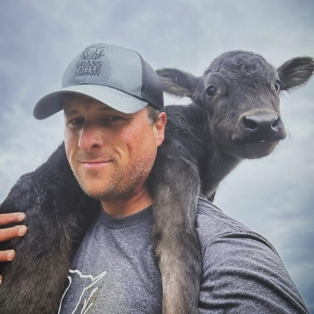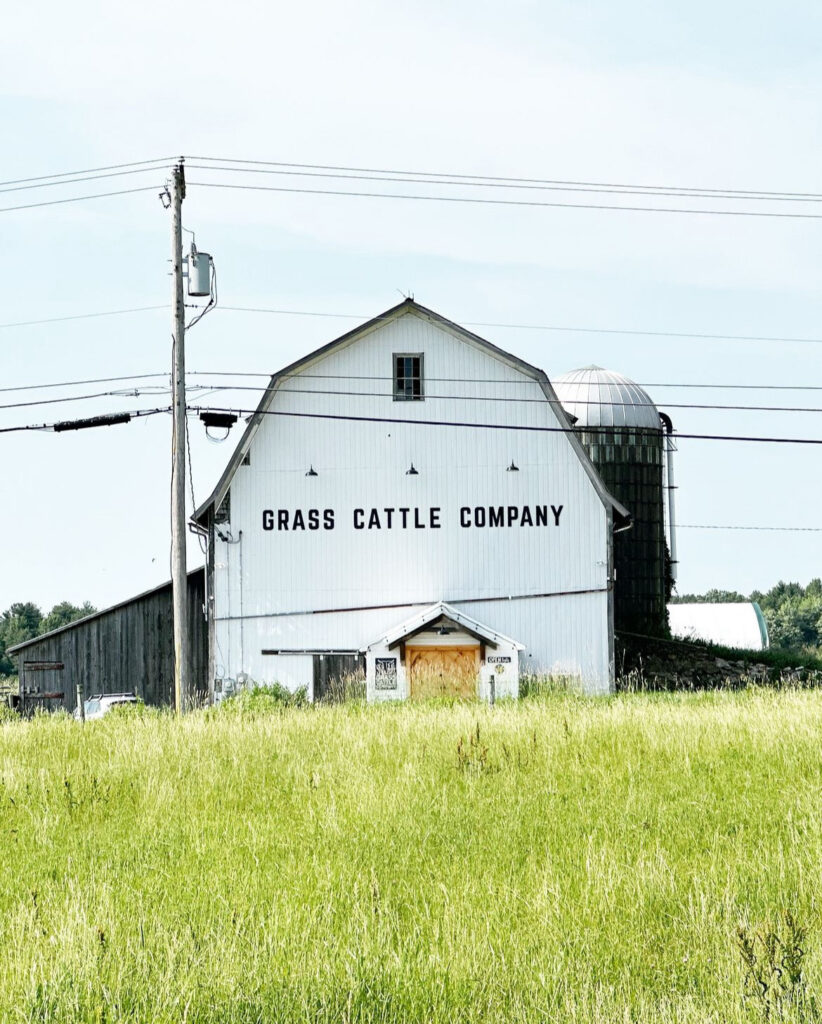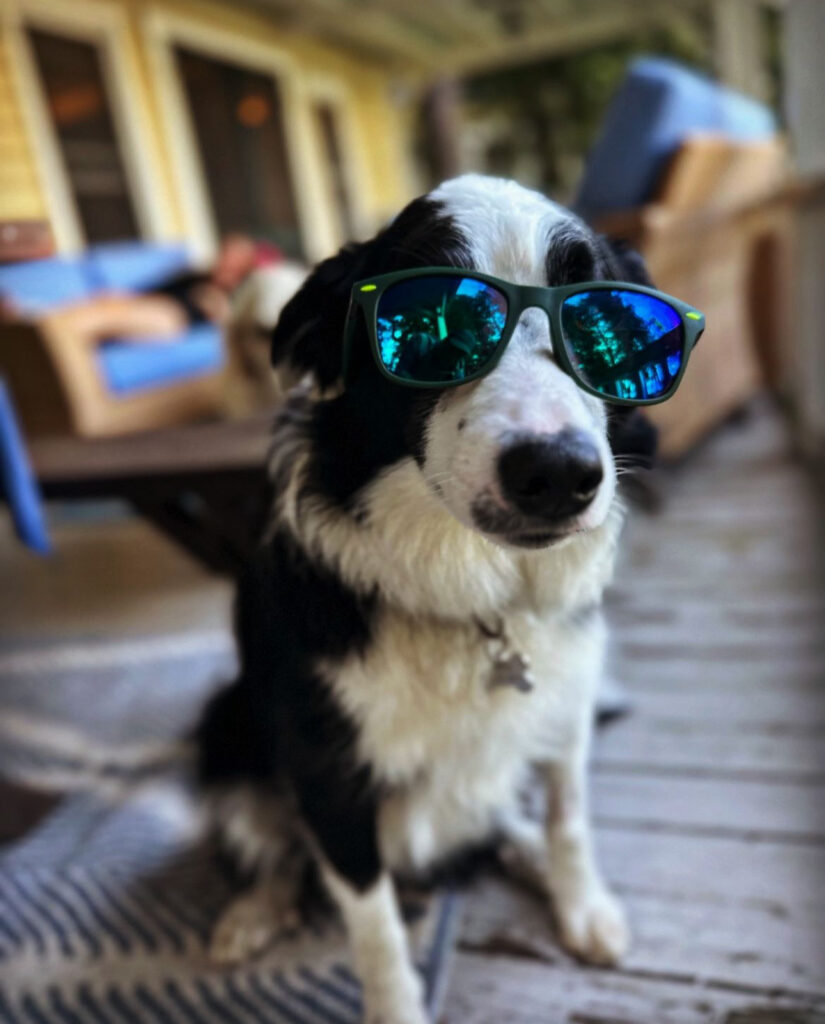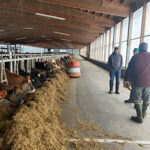
This summer, we sat down with a new member of the Champlain Valley Farmer Coalition: Steve Schubart, first-generation beef rancher and owner of Grass Cattle Company in Charlotte, Vermont. When he’s not thinking about how to disrupt the beef industry, Steve hosts high school student interns through our Lake Champlain Sustainable Agriculture Program, inspiring them to pursue careers in agriculture.
Champlain Valley Farmer Coalition: How did your farm get started?
Steve Schubart: My idea for Grass Cattle Company started when I was working at Stemple Creek Ranch, a cow-calf operation in California. I was studying economics out there in 2013. They started marketing their own grass-fed beef by circumstance: A grass-fed steer broke its leg and they realized, “Oh, this actually has fat and it’s not terrible.” There was also great timing of grass-fed beef becoming ‘a thing’ in the marketplace. Stemple Creek is now one of the more progressive direct-to-consumer, grass-fed beef operations; it’s even recognized here in Vermont by fellow regenerative ag practitioners. Because of my experience there, I decided to shift my education to agriculture and I looked at all of the ag programs in Vermont. I landed on Vermont Tech’s Diversified Agriculture Bachelor of Science, with a degree in Dairy Herd Management, as well.
CVFC: Before you started working at Stemple Creek, had you had any experience in agriculture?
Schubart: I had worked on some farms, but it was actually all vegetable farms. We had large animals growing up, pasturing livestock, including horses, llamas, donkeys, peacocks, goats, and chickens. So, we had a real hobby farm. I transferred into Vermont Tech in 2014, graduated in 2016, and simultaneously started Grass Cattle Company on 30 leased acres in Shoreham at Cream Hill Stock Farm. I had a USDA FSA micro-loan, which is a loan under $50,000, and I bought 30 head of beef cattle.
CVFC: How long did it take from when you initially bought that 30 head to actually have saleable beef?
Schubart: It took about nine months because I bought feeder cattle that I was finishing. I learned a lot the first year. I learned a lot about what the proper finishing weight of cattle is and average daily gains and what is marketable high-quality grass-fed beef versus grass-fed beef that is a grass-fed product by default because it was either too young or too old.
CVFC: Who do you farm with?
Schubart: I’m a single owner LLC, and have been since 2016. I had a day job up until about a year ago. In the spring of 2022, I hired Ian, our Farm Manager, who is a UVM grad. He’s a Vermont kid. He completed the UVM Farmer Training Program and was an assistant livestock manager at Philo Ridge Farm for three years. I hired him as our manager so I could focus on business development.
CVFC: Tell us more about your role on the farm.
Schubart: My role now is a lot of business development because we have figured out a system where we can raise livestock with minimal input within an ecosystem where the cattle are doing most of the traditional work associated with a farm for us. They harvest the feed, they fertilize the feed, they water the feed.
And because we have a good grazing manager–our farm manager, Ian–we get about five grazings per season off our 162 acre farm. We graze about 152 of those acres.
Because our production methods are so ecosystem reliant, it means a lot of what I’m tasked with doing is figuring out how do we take this regenerative ag business and make it profitable? Make it pay for my farm manager and myself? And, hopefully, pay for the acquisition of more land and livestock to increase our production and our impact?
I do a lot of developing new markets with small regional wholesale buyers, which is different than our market when I started. Back then, everything I was selling was by the trailer load to wholesale buyers who would then put their name on it for resale, which is really common for a commodity program.
When prime interest rates became 8% and not 2.5+%–which is where they were when I started–I had to really decide if I wanted to keep growing the business on borrowed money, or what our model was going to be. The timing worked out with leaving my day job and the increase in prime interest rates. I said, ‘We’re pivoting from wholesale markets of live cattle to 100% direct-to-consumer cut beef under our own brand.’
CVFC: That’s awesome! How many animals are you up to now?
Schubart: We have 15 cow-calf pairs and we have 30 head of beef. Those are last year’s calves and some feeder cattle we bought because we’re also transitioning our business from a finisher model where we’d buy weaned calves and graze them for almost 18 months to a model that’s cow-calf to finish. In this way, we own the parent herd and can control genetics, quality, and their impact. We basically own the animal through its entire lifecycle, birth to death.

CVFC: You are primarily a beef operation, but we saw some chickens around here, too, right?
Schubart: Yes, we diversified into chicken this year. We’re raising organic pasture-raised chicken. We also have a layer operation, although that is not ours. Ian, our Farm Manager, runs it and wholesales his eggs to our company. That said, Grass Cattle Company is about to get into the layer business, as well, because we’re opening up a second farm store and we already sell out of our eggs every morning.
CVFC: What’s happening on your farm this week?
Schubart: This week, we just moved our 120 chicks from the brooder to our pasture coops. The coops are 16-by-16 foot boxes that are 2-feet tall. We rotate those once-a-day, and they’re all on a pressurized waterline. All of our coops are daisy-chained together by a sapline. The water is automated for all of our pasture chicken. We’re also cleaning! We’re cleaning out our bedded pack barn, which means we’re scraping manure and composted hay out of a barn. Every day, we rotate our cattle. That’s a daily chore.
CVFC: That’s a really good segue because we’d love to hear all about what you’re doing to support water quality, soil health, and addressing climate change. And we know your rotational grazing program is a big part of that.
Schubart: We think of our farm as an ecosystem, and we’re playing a role as ecosystem managers. For an ecosystem to be functioning, you have to work with nature, not against it. For us, that means allowing cattle to express their ‘cowness’ and go out and graze grass and be under the sun. In turn, we practice rotational grazing. What we’re trying to mimic are the bison herds that roamed the most fertile soils of our country a few hundred years ago. The bison herds were grazers. They would go in and they would take one bite, they’d defecate, they’d urinate. The predators would keep them in a tight group, and they’d trample down everything they didn’t eat on top of the soil. This fed the soil and mulched the soil and allowed those roots to stay moist and allowed the soil to stay living.
Our cows come, they take one highly nutritious bite. It doesn’t require a lot of metabolic energy to get it because they’re not doing this constant sheep-type biting into the lawn, which you can imagine is very labor-intensive to get calories. When you have a really thick stand of feed, an ungulate’s tongue is designed to grab all of it, rip it right up, and have a very big, high calorie bit for the amount of work that they’re doing.

CVFC: Is that a function of how cows eat versus how sheep eat, or how you maintain your pastures?
Schubart: It’s more a function of how you maintain your pastures. If we let our pastures get down to lawn height, it’s going to take them a lot longer to regenerate. We know what’s going on above the soil is what the roots look like below the soil. All of those grass leaves are the solar panels that allow photosynthesis to happen. If you don’t have those, you’re drawing energy from the roots and slowing their growth. It makes it a lot harder to grow your own feed. And that gets expensive when you start adding in a whole bunch of heavy equipment and expensive fertilizer bills. That’s the other piece of what we’re doing related to climate: We’re able to grow nutrient dense food without a lot of inputs. I think the general public is starting to question, ‘How do different farm production models impact our food and our environment?’
CVFC: We noticed you don’t make a paddock every day, but seem to drag a line around from a pivot point. Can you tell us what we’re seeing?
Schubart: We use things called tumble wheels. The pivot point is simply where the reel of polywire is. It’s a psychological electric fence barrier that we think of as the predators to keep the herd in a tight group. We affix those temporary fence reels to random parts of the barrier fence. We use these because it’s very low labor, and we don’t have to take down a fence and set one back up every time.
CVFC: Do you synchronize your chickens and your cows?
Schubart: We don’t have our chickens following our cow herd because we have a dung beetle population that we value. The dung beetles help break down the manure in our field. That’s more important to us than having our chickens eat the fly larvae out of the manure. We just don’t want our chickens to eat the dung beetles. While our chickens get rotated every day, we don’t have enough of them to necessitate them being on a tighter rotation with our livestock. We have what looks like an abundance of feed–standing pasture–right now because we plan for an abundance of feed. This keeps our pasture ecosystem healthy as well as our cattle.
CVFC: You give each section of pasture forty days to recuperate before the cattle come back again. Why forty days?
Schubart: Forty days is our minimum. Sometimes it will be more like 60. But forty days is the minimum we think we need to let our pasture grow back. There’s a lot of grass-fed, grazed livestock eating the grass down to the lawn where they have to work hard for caloric intake. And then the grass has to work so hard to grow back, and it’s just never able to grow. By waiting at least forty days, we’re letting the land regenerate.
CVFC: What other environmental practices are you using in addition to rotational grazing?
Schubart: It probably goes without saying, but because we do rotational grazing and only feed hay, we don’t grow any crops. Monocrops are one of those things that aren’t found in nature. I’ve learned that to grow one thing over and over and over requires a lot of inputs, and generally, those inputs destroy an ecosystem.

CVFC: We needed to reschedule our interview a couple of times because we had an historic heatwave in June. We’ve also been getting torrential downpours. It’s clear the climate is changing. What impact does a changing climate have on you as a farmer, as well as the animals and land you steward?
Schubart: What’s crazy about rotational grazing and all of this organic matter we’re adding to our soil from rotational grazing is that we’re not as susceptible to climate extremes. According to the USDA, for every 1% increase in your soil organic matter, you’re increasing the water holding capacity in the top 6 inches of soil. I’ve heard anywhere from 26-27,000 gallons. So when we have these big rain events, we’re noticing a lot of our fields just bouncing back. We don’t see a lot of streams forming where erosion would happen.
CVFC: How are your cattle faring in these extreme temperatures?
Schubart: Our cattle seem to be doing great. We body condition score them. Shade for livestock means that they’re either not rotational grazing and they’re just sitting under a tree all day, destroying that land and compacting it. Or it means that they’re generally kept in a barn where then you have to bring feed to them. Then you have to scrape that manure out and then you have to put that manure on a field to grow more feed in this system that’s heavily reliant on iron and oil. It’s the antithesis of what we’re doing. While I’d love to sit around all day in the shade and have food brought to me, it’s not the best thing for me. It’s not a quality of life any living creature deserves.
So we have trees that border all of our pastures, and there’s shade. On the 90-degree days, we open up our wooded area for them.
Sometimes we have to sacrifice some land because it got grazed more than we wanted it to. But I’m constantly evaluating the ecosystem with three lenses: there’s the land lens, the cow lens, and the business lens. Sometimes what’s best for the cows isn’t what’s best for the land. If it all doesn’t cash flow and become somewhat profitable, what am I doing this for anyway? It’s not a hobby. It’s not a nonprofit. This is to show that there’s a system of raising nutrient dense food in an ecosystem that doesn’t involve heavy inputs, that doesn’t have to be that much more expensive than the grocery store, and is still profitable to a small farm. To me, that is the win. And, when I die, that’s where I’m excited my impact will be.
CVFC: As you’ve been working to implement innovative practices, what would you say has helped you to be successful?
Schubart: All of the help I’ve received from farming friends, mentors, professionals, and the ag program heads at Vermont Tech. Friends and neighbors who’ve lent me tractors, who’ve shown up when we need to have 40,000 pounds of feeder cattle pulled out of a load stuck in our front door yard. My goal for agriculture is to disrupt the conventional systems a little bit, and for most of the people in my circle, that is also their mission. I also think about collaboration over competition, doing what’s right, trusting my gut, and following my morals.
CVFC: Why is it important to you as a farmer to be a good steward of the environment?
Schubart: I want my kids–my future children I don’t have yet–to grow up in a world where they’re not told that agriculture or milk or beef is bad for you and the environment. People want good, nutrient dense food and good stuff for the environment and good stuff for their kids. I want to be a part of that vision and solution.
CVFC: You’ve been hosting high school student interns through our Lake Champlain Sustainable Agriculture program. (Thank you!) Why did you decide to get involved with this program when you have a million other farmer things to do?
Schubart: I want to help spur some change and inspire young farmers because we need more farmers, however they’re farming, whatever they’re farming. We need more humans and human-scale agriculture touching our food and having a say in how our food is grown and produced. It was awesome to have the interns here. They were really great and we put them right to work. We talked a lot about what it was like doing business as a first-generation farmer.
CVFC: What kinds of questions are the kids bringing to the table?
Schubart: They were curious about everything. I mean, everything! I think it’s important to inspire young folks that what I’m doing is attainable and you don’t need to be a rich person. You can scrounge and save and write good business plans to get the bank to back you.
I get excited about seeing other people think that this is attainable as a first-generation farmer.
Because we need them.
Learn more about Grass Cattle Company by visiting them on the web, or follow Steve in his daily agriculture adventures on Instagram @grasscattlecompany.




